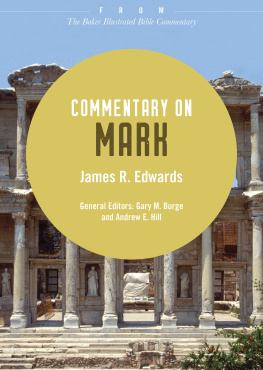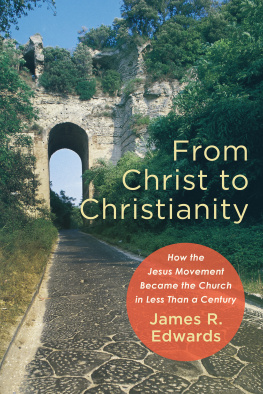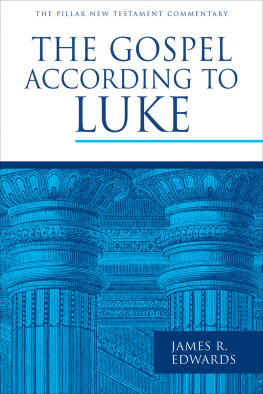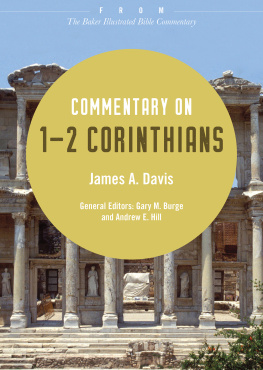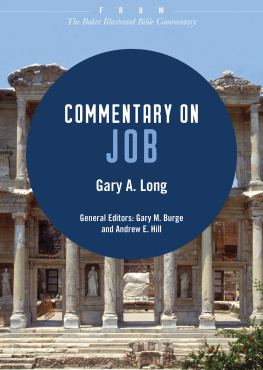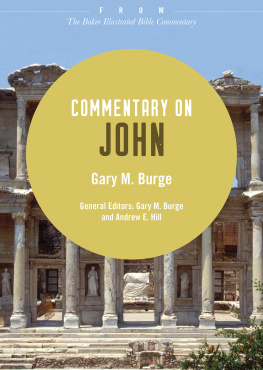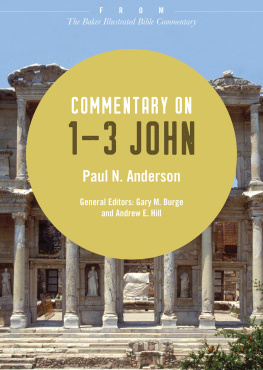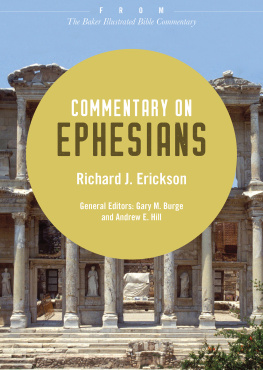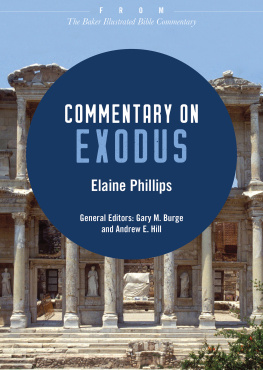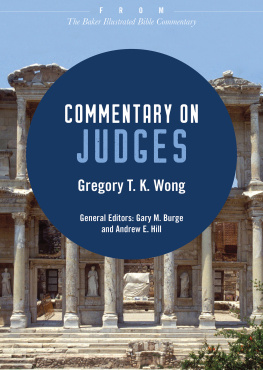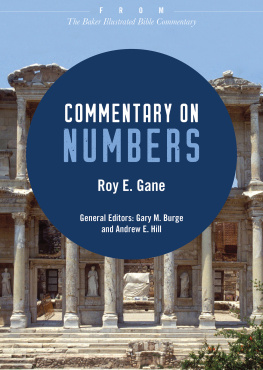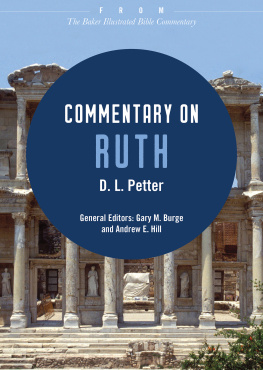James R. Edwards - Commentary on Mark: From The Baker Illustrated Bible Commentary
Here you can read online James R. Edwards - Commentary on Mark: From The Baker Illustrated Bible Commentary full text of the book (entire story) in english for free. Download pdf and epub, get meaning, cover and reviews about this ebook. year: 2019, publisher: Baker Publishing Group, genre: Religion. Description of the work, (preface) as well as reviews are available. Best literature library LitArk.com created for fans of good reading and offers a wide selection of genres:
Romance novel
Science fiction
Adventure
Detective
Science
History
Home and family
Prose
Art
Politics
Computer
Non-fiction
Religion
Business
Children
Humor
Choose a favorite category and find really read worthwhile books. Enjoy immersion in the world of imagination, feel the emotions of the characters or learn something new for yourself, make an fascinating discovery.
- Book:Commentary on Mark: From The Baker Illustrated Bible Commentary
- Author:
- Publisher:Baker Publishing Group
- Genre:
- Year:2019
- Rating:5 / 5
- Favourites:Add to favourites
- Your mark:
- 100
- 1
- 2
- 3
- 4
- 5
Commentary on Mark: From The Baker Illustrated Bible Commentary: summary, description and annotation
We offer to read an annotation, description, summary or preface (depends on what the author of the book "Commentary on Mark: From The Baker Illustrated Bible Commentary" wrote himself). If you haven't found the necessary information about the book — write in the comments, we will try to find it.
Commentary on Mark: From The Baker Illustrated Bible Commentary — read online for free the complete book (whole text) full work
Below is the text of the book, divided by pages. System saving the place of the last page read, allows you to conveniently read the book "Commentary on Mark: From The Baker Illustrated Bible Commentary" online for free, without having to search again every time where you left off. Put a bookmark, and you can go to the page where you finished reading at any time.
Font size:
Interval:
Bookmark:
2012 by Baker Publishing Group
Published by Baker Books
a division of Baker Publishing Group
P.O. Box 6287, Grand Rapids, MI 49516-6287
www.bakerbooks.com
Ebook short created 2019
Previously published in The Baker Illustrated Bible Commentary edited by Gary M. Burge and Andrew E. Hill in 2012
All rights reserved. No part of this publication may be reproduced, stored in a retrieval system, or transmitted in any form or by any meansfor example, electronic, photocopy, recordingwithout the prior written permission of the publisher. The only exception is brief quotations in printed reviews.
Library of Congress Cataloging-in-Publication Data is on file at the Library of Congress, Washington, DC.
ISBN 978-1-4934-2464-1
Unless otherwise indicated, Scripture quotations are from the Holy Bible, New International Version. NIV. Copyright 1973, 1978, 1984, 2011 by Biblica, Inc. Used by permission of Zondervan. All rights reserved worldwide. www.zondervan.com. The NIV and New International Version are trademarks registered in the United States Patent and Trademark Office by Biblica, Inc.
Scripture quotations labeled ESV from The Holy Bible, English Standard Version (ESV), copyright 2001 by Crossway, a publishing ministry of Good News Publishers. Used by permission. All rights reserved. ESV Text Edition: 2007
Scripture quotations labeled NASB are from the New American Standard Bible, copyright 1960, 1962, 1963, 1968, 1971, 1972, 1973, 1975, 1977, 1995 by The Lockman Foundation. Used by permission. www.lockman.org
Scripture quotations labeled NIV 1984 are from the HOLY BIBLE, NEW INTERNATIONAL VERSION. NIV. Copyright 1973, 1978, 1984 by International Bible Society. Used by permission of Zondervan. All rights reserved.
Scripture quotations labeled NJPS are from the New Jewish Publication Society Version 1985 by The Jewish Publication Society. All rights reserved.
Scripture quotations labeled NKJV are from the New King James Version. Copyright 1982 by Thomas Nelson, Inc. Used by permission. All rights reserved.
Scripture quotations labeled NLT are from the Holy Bible , New Living Translation, copyright 1996, 2004, 2007 by Tyndale House. Used by permission of Tyndale House Publishers, Inc., Carol Stream, Illinois 60188. All rights reserved.
Scripture quotations labeled NRSV are from the New Revised Standard Version of the Bible, copyright 1989, by the Division of Christian Education of the National Council of the Churches of Christ in the United States of America. Used by permission. All rights reserved.
Scripture quotations labeled RSV are from the Revised Standard Version of the Bible, copyright 1952 [2nd edition, 1971] by the Division of Christian Education of the National Council of the Churches of Christ in the United States of America. Used by permission. All rights reserved.
Unless otherwise indicated, photos, illustrations, and maps are copyright Baker Photo Archive.
| ANET | Ancient Near Eastern Texts Relating to the Old Testament . Edited by J. B. Pritchard. 3rd ed. Princeton, 1969 |
| BDAG | Bauer, W., F. W. Danker, W. F. Arndt, and F. W. Gingrich. Greek-English Lexicon of the New Testament and Other Early Christian Literature. 3rd ed. Chicago, 1999 |
| ca. | circa (about, approximately) |
| cf. | compare |
| chap(s). | chapter(s) |
| COS | The Context of Scripture . Edited by W. W. Hallo. 3 vols. Leiden, 1997 |
| e.g. | for example |
| ESV | English Standard Version |
| HALOT | Koehler, L., W. Baumgartner, and J. J. Stamm. The Hebrew and Aramaic Lexicon of the Old Testament. Translated and edited under the supervision of M. E. J. Richardson. 5 vols. Leiden, 19942000 |
| HCSB | Holman Christian Standard Bible |
| i.e. | that is |
| KJV | King James Version |
| NASB | New American Standard Bible |
| NEB | New English Bible |
| NET | New English Translation |
| NIV | New International Version (2011 edition) |
| NIV 1984 | New International Version (1984 edition) |
| NJB | New Jerusalem Bible |
| NJPS | The Tanakh: The Holy Scriptures: The New JPS Translation according to the Traditional Hebrew Text |
| NKJV | New King James Version |
| NLT | New Living Translation |
| NRSV | New Revised Standard Version |
| RSV | Revised Standard Version |
| TDOT | Theological Dictionary of the Old Testament . Edited by G. J. Botterweck and H. Ringgren. Translated by J. T. Willis, G. W. Bromiley, and D. E. Green. 8 vols. Grand Rapids, 1974 |
| TNIV | Todays New International Version |
James R. Edwards
Introduction
For the first seventeen centuries of church history, Mark, the shortest of the four Gospels, was regarded as an inferior abbreviation of the Gospel of Matthew. Discussions of the Gospels in the early centuries of Christianity cite Matthew and John most frequently, Luke a distant third, and Mark last and only rarely. Until modern times, church lectionaries likewise included citations from Luke and Mark only when they differed from Matthew and John, which were regarded as the two most important Gospels. In the early nineteenth century, however, careful literary analyses of the first three Gospels led a majority of scholars to hypothesize that Mark was not a servile abbreviator of Matthew but rather the earliest of the Gospels, and the primary source for both Matthew and Luke. This radical reevaluation of Mark has resulted in two centuries of unprecedented attention and a flood of literature devoted to the Gospel of Mark.

Authorship, Date, Place of Composition, and Audience
Like the other canonical Gospels, Mark nowhere identifies its author, nor even, as is the case with Luke (1:14) and John (20:3031), the occasion of writing. Early and reputable witnesses, however, including Papias, Eusebius, Clement of Alexandria, and Origen, attest that the second Gospel derives from John Mark, who, although not an apostle, was a faithful interpreter of Peter, whose testimony was the chief source of Marks Gospel. This John Mark, the son of Mary in whose house the early church gathered in Jerusalem (Acts 12:12), was an assistant on Pauls first missionary journey. Although he quit the journey at Perga (Acts 12:25; 13:4, 13), the New Testament indicates he later traveled with Barnabas (Acts 15:3741), was reconciled with Paul (Col. 4:10; Philem. 24; 2 Tim. 4:11), and finally joined Peter in Rome (1 Pet. 5:13). The aforementioned church fathers state that Mark composed the Gospel in service of Peters preaching in Rome, although he took liberties with the chronological order of some events. The Gospel must have been composed sometime after AD 64, when Peter arrived in Rome, but probably before the fall of Jerusalem in AD 70, for chapter 13, which reflects some aspects of the First Jewish Revolt, does not seem to reflect the fall of Jerusalem.
If Mark composed the Gospel in Rome and for Roman Christians, then his primary audience was Roman Gentiles. This is corroborated by the fact that Mark seldom quotes from the Old Testament, explains Jewish customs unfamiliar to Gentiles (7:34; 12:18; 14:12; 15:42), translates Aramaic and Hebrew phrases by their Greek equivalents (3:17; 5:41; 7:11, 34; 10:46; 14:36; 15:22, 34), and incorporates a number of Latinisms.
Font size:
Interval:
Bookmark:
Similar books «Commentary on Mark: From The Baker Illustrated Bible Commentary»
Look at similar books to Commentary on Mark: From The Baker Illustrated Bible Commentary. We have selected literature similar in name and meaning in the hope of providing readers with more options to find new, interesting, not yet read works.
Discussion, reviews of the book Commentary on Mark: From The Baker Illustrated Bible Commentary and just readers' own opinions. Leave your comments, write what you think about the work, its meaning or the main characters. Specify what exactly you liked and what you didn't like, and why you think so.

